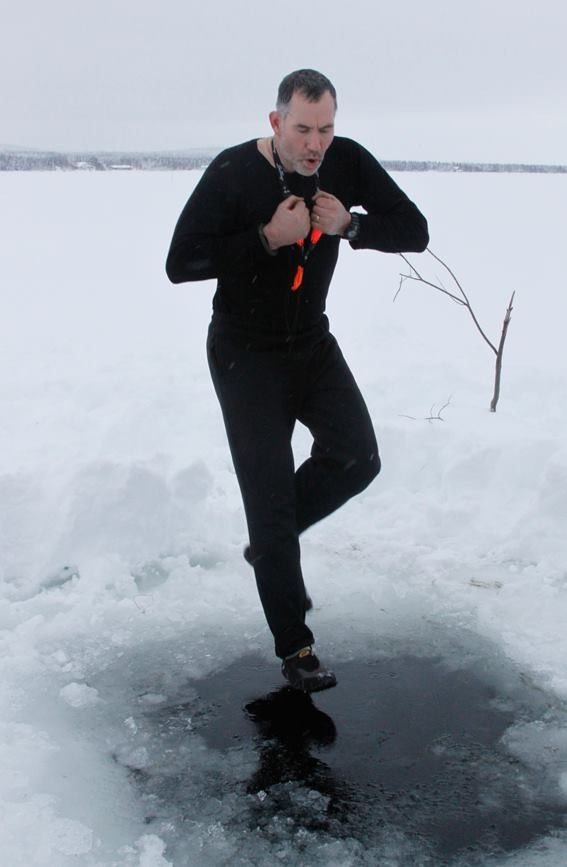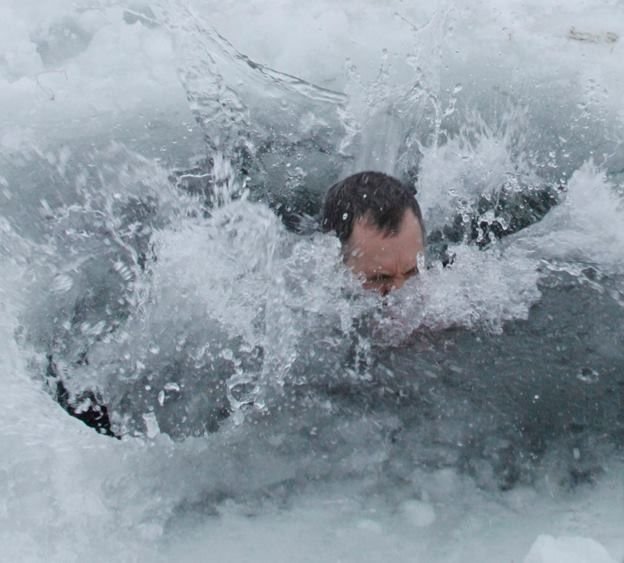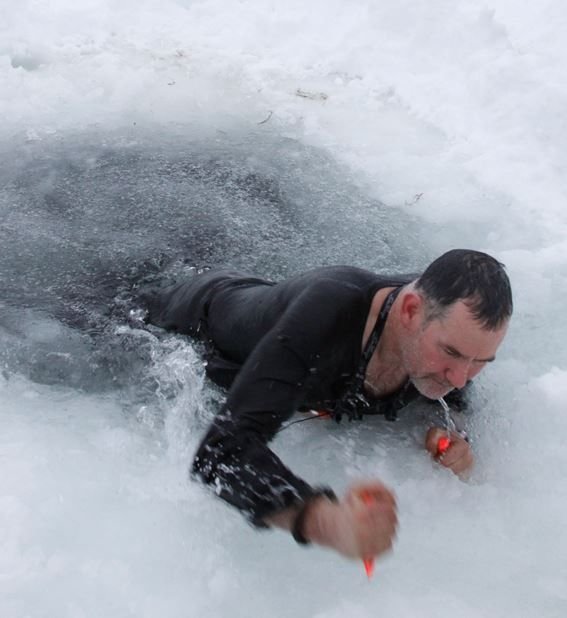The human body is not meant to do these kinds of things ... but then again maybe it is? Certainly our modern lives are very insulated - in every sense of the word. We move from centrally heated house, to car, to office, fully wrapped against the elements. But what if we were to embrace the cold, to be fully exposed to it's icy grasp? What would happen? As a survival instructor these are the kinds of questions I like to grapple with.
Sawn from foot-thick ice, we push the great door of frozen water down into the depths where it disappears from view. It is up to me now. I stand on the edge - the air temperature -10 degrees C. I tell myself not to think and then I step off, icy water engulfing me. I control the gasp response as the shock of the cold courses through my veins...
Every year in the Arctic, snow mobiles accidentally fall through the ice and their drivers are forced into exactly this scenario. Some people suffer instant heart attacks from the cold shock, or inhale water due to the gasp reflex and drown. Getting out is not easy either. The fact that the ice has cracked means it is thin and compromised, and in the mad scramble to get out more ice breaks away. At this point the survival clock is ticking. In a matter of minutes your peripheral blood supply will shut down making it hard to grip and operate your hands. Already it is nearly impossible to climb out on your own and soon you will not even be able to swim. You move quickly through the stages of hypothermia to unconsciousness where drowning is more or less inevitable.
Hypothermia is technically the cooling of the body core from it's normal temperature of 37 degrees C down to 35 and below. Immersion hypothermia in cold or near freezing water dramatically accelerates the process compared to cold weather exposure. Common stages of hypothermia include uncontrollable shivering, and drunken-like symptoms, as the brain slows down. Sometimes victims even experience feelings of intense heat at this stage and may undress to "cool down" (this is called paradoxical undressing!). As shivering ceases - the victim enters a particularly dangerous phase, often closely followed by coma. With hypothermia there is an old saying - you are never cold and dead, only warm and dead. This means that even if the person has no vital signs it may be possible to slowly re-warm and revive them in hospital. This cannot be done in the field; in fact exposure to heat in the later stages of hypothermia can be fatal, as the little remaining heat flows from the core to the extremities.
...The cold feels like a vice on my head and I see the light above beckoning me back to the land of the living. As soon as I break the surface I breathe and I am reaching for my ice picks, focusing hard on the task in hand - my life depends on it! I swim hard towards the ice rim and plunge the picks into the thick ice, dragging myself out on my belly like a seal. I feel the traction and I am quickly standing and flapping my arms to warm up. I am euphoric. The exercise has a serious purpose though - it is the concluding part of one of our Arctic survival courses. The idea is to physically and mentally prepare oneself for a fall through the ice - to know what it feels like and what to do.
You can find a lot of statistics on survival times in water and the progress of hypothermia, this is what I have always taught. Recently, however, I have been wondering if this is necessarily the case. Perhaps it is possible to train ourselves to cope with the cold in a way that is not widely recognised, or even thought possible. Enter Wim Hof, a Dutchman in his 50s, who has pioneered his own method for withstanding extreme cold. He has an impressive collection of cold endurance records which have been scientifically monitored and verified.

For example, he has sat up to his neck in an ice bath for two hours without his core temperature dropping, he has run a marathon in the Arctic wearing just shorts, and similarly has climbed high on Everest. He also has the record for swimming for 80 m under the ice. His belief is that anyone can train themselves to endure cold in this way using a combination of breathing exercises, gradual cold exposure and mental focus.
It reminds me of the gargantuan survival epics that were undertaken by the likes of Shackleton and his men. They prevailed for months in atrocious conditions, undernourished and with little hope of survival. Something physical may have changed in these men that enabled them to cope with the extreme cold for prolonged periods. Perhaps a change in the way their bodies shut down their peripheral blood supply? It is found that some indigenous people like the Sami and Inuit have higher concentrations of brown fat in their bodies which they can metabolise to generate heat. Building brown fat and improving the vascular shutdown control are some of the mechanisms that Hof postulates to explain his method.
Furthermore, controlled and gradual exposure to cold can not only help us cope with the extreme temperatures but it can be very good for our health and wellbeing. It is a bit like pressups for the cardio-vascular system! Hof's method has also been scientifically proven to gain control over the auto-immune system and help to fight off diseases.
Inspired by these ideas, in February, I started taking daily swims in the sea (no wetsuit) and learning the Wim Hof Method. It has been an amazing, life-affirming experience. I am looking forward to taking it further this coming winter. I also plan to write a post on my experience with the Wim Hof Method at some point.



WOW! just WOW! on all accounts to what you have acomplished and are pushing yourself to learn.
Thanks @snook :)
Its funny you mention paradoxical undressing because I saw it in an episode of Archer! its amazing to see how the body handles in extreme conditions of weather and its amazing the knowledge you have on temperature change in freezing water. Good to know for my next trip to Alaska
Cheers
Dante
http://www.tzr.io/yarn-clip/777cfc34-f9e2-44f3-b8ed-f295cc0bdafd#Bkc0guNxhW.copy
Really, in the Archer? :) Trip to Alaska sounds good!
Congratulations @wildwood! You received a personal award!
You can view your badges on your Steem Board and compare to others on the Steem Ranking
Vote for @Steemitboard as a witness to get one more award and increased upvotes!